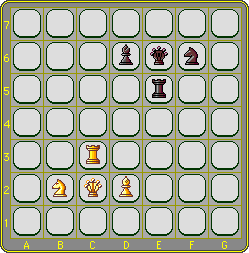Page 4 of 33
Caïssa
 | Caïssa employs a different implementation of the 'atlantis effect'. On top of that, Caïssa introduces another absolute novelty: 'capture by exchange', which is in fact no capture at all. In the initial position the board is covered with 49 tiles.
|
 | The Queen The king's role is played by the queen. The diagram on the left shows its options for movement and capture in a non-check situation. |
 | If in check, it is restricted to adjacent squares, as shown in the diagram on the right. Thus pieces giving check from a distance, need no cover. The queen is the only piece with the power of capture in the usual sense. The atlantis effect If the queen moves, the tile it vacates is removed in the same turn. The removal is compulsory, but it may not violate the tile-connection rule. The mutual check rule Queens may not see one another along the same rank, file or diagonal, so neither player may effectuate that situation. Thus a Queen may protect a piece against capture by it's counterpart. |
 | The pieces move as in Chess. Under the implicit condition of not putting its own queen in check and the explicit condition of not violating the connection rule, a piece can always move to any of its target-squares, whether or not it is tiled, and if it is, whether or not it is occupied, and if it is, regardless of the color of the occupying piece!
|
 | About tile-surfing and the connection rule This 'mate in 1' shows another application of tile-surfing and the connection rule. For clarity all other pieces have been omitted. After d2c4, the queen cannot move because the tile on c1 would be disconnected. If black were able to exchange the knight on c4 immediately with any of his pieces, he could yet prevent the mate, but the queen would remain immobile until one of black's pieces would bring a tile to the rescue. |
Applet
download applet play online a word on notation |
You can download this MindSports applet, which is tailored to save games played in the Pit, offline. |
External links
- Caïssa @ ZillionsCaïssa has been implemented on the Zillions game machine.
- Caïssa @ The Chess Variant Pages
- In the 2003 CodeClub Challenge, Caïssa was subject of the annual game programming contest in the Netherlands.
Caïssa © MindSports
Java applet © Ed van Zon
